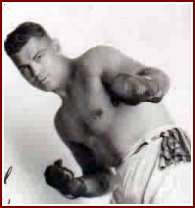| Jack Dempsey, the movie from 1983 stars Treat Williams and Sally Kellerman. The “Manassa Mauler’ walks across the screen and shows the life of Jack Dempsey. With him in the movie, it represents the last picture show of him since he died that year. The film opens in Utah in 1911, where the teenage Dempsey works out in hopes of cracking the big time. Eight years later, |  |
Dempsey enters into his famous bout with reigning champion Jess Willard. From 1919 through 1926, Dempsey keeps the heavyweight championship title; he also carries on a wild and profligate private life, including an expensive marriage and even more expensive divorce with silent film star Estelle Taylor, his second wife and played by Victoria Tennant. Deanna Piatelli stayed with him until his death and she was the most loyal of his four wives. He also married Hannah Williams. Maxine Gates, played by Sally Kellerman and first of his wives, married Dempsey from 1916 until 1919. Treat Williams trained with Al Silvani, who worked with Stallone on the earliest Rocky epics. An excellent movie to watch and gather the facts of Dempsey’s life. He appears in the movies as himself and archive footage.
Jack Dempsey actually starred in several other movies, Damn Citizen (1958), Off Limits (1953), Manhattan Madness (1925), Winning His Way (1924), Bring Him In (1924), All’s Swell on the Ocean (1924), West of the Water Bucket (1924), Daredevil Jack (1920), Big Wheel (1949), Requiem for a Heavyweight (1962), Sweet Surrender (1935), Stars Over Broadway (1935), Mr. Broadway (1933), Prizefighter and the Lady (1933), and Every Woman’s Man (1933). Dempsey got pictured on one of fifteen 32¢ US commemorative postage stamps in the “Celebrate the Century” series, issued on the third of February 1998, celebrating the 1910’s.
The smell of sweat fills the tiny room of screaming fans. Two bobbing and weaving boxers are in a small ring, desperately trying to wear the other out. The primitive intensity of the fight continues to grow. Fatigue begins to set in on the opponent. The ultimate look of fear sets in the opponent’s eyes as Jack Dempsey’s fist comes flying towards his face. The eyes close as a powerful and ferocious blow ensues. The opponent’s body crumbles to the floor and his last recollection is the bell sounding Jack Dempsey’s victory. Fate met many of the boxers who faced Jack Dempsey in the 1920’s.
Jack Dempsey still represents one of America’s first great sports heroes. He stood his ground at just over six-feet and weighed in at one-hundred-and-ninety-pounds. His savage style captivated the public and made him as popular a figure as Babe Ruth or Red Grange. In the ring, Dempsey dropped bombs in a two-fisted attack. He boxed out of a low crouch, bobbing, weaving and bombing. He continually stalked the man in front of him, never stopping an unrelenting and remorseless assault. His power was so prodigious that he once scored knockouts in fourteen seconds. In his seventy-eight-bout career, Dempsey compiled forty-nine knockouts, with twenty-five of them in the first round.
William Harrison Dempsey started life in Manassa, Colorado and one of eleven children. He left home at the age of sixteen and traveled the west on freight trains with hobos, settling occasionally in mining towns. Dempsey learned how to fight as a means of survival. Dempsey’s career turned around when he met manager Jack “Doc’ Kearns. Under Kearns, Dempsey knocked out Fireman Jim Flynn, Fred Fulton, former light heavyweight Battling Levinsky and Gunboat Smith.
On July 4, 1919, Dempsey challenged heavyweight champion Jess Willard at an outdoor arena in Toledo, Ohio. Jess Willard out weighed Dempsey by sixty-pounds, and was taller by more than six inches in height. Temperatures in the ring reached one-hundred degrees that day. Willard dropped seven times in the first round. Willard met the pure rage of Dempsey. The fight ended when Willard failed to answer the bell for the fourth round. Dempsey won the heavyweight crown from the champion with perhaps the most fearsome offensive explosion ever seen in the ring. Dempsey won on a third-round knockout. Promoter Tex Rickard immediately began calling him “Jack the Giant killer’ because Willard got the name as the “Pottawatomie Giant.’ Dempsey made easy title defenses against Billy Miske, Bill Brennan, Georges Carpentier Tommy Gibbons. The Carpentier fight generated boxing’s first million-dollar gate. Dempsey proved far too good for the great world light heavyweight and European heavyweight champion.
On September 14, 1923, Dempsey continued his legend when he faced Argentina’s Luis Angel Firpo at the Polo Grounds in New York. Known as the “Wild Bull of the Pampas,’ Firpo dropped seven times in the first round. Firpo stood three inches taller and out weighed Dempsey by thirty-pounds, another giant for Jack to kill. Every time Jack Dempsey knocked Firpo down, Dempsey stood over him so he started to attack the instant Firpo got to his feet. As a result, New York boxing authorities changed the regulations to require a boxer to go to a neutral corner after scoring a knockdown, and Illinois adopted the same rule. But before the stanza ended, the challenger sent Dempsey through the ropes with a single right hand, silencing the 80,000 in attendance. Dempsey made it back into the ring and beat the ten-count. The fight ended fifty-seven seconds into the second round with Dempsey a knockout winner.
After fighting only exhibitions and making vaudeville appearances for three years, Dempsey matched against Gene Tunney on September 23, 1926, at Philadelphia. Badly out of shape, he lost the title on a ten-round decision to the quick, clever Tunney. At thirty-one, Dempsey fell behind on points and was never able to change the momentum. Dempsey returned to the ring after a three-year layoff and lost the title to perhaps the greatest pure boxer ever to grace the heavyweight division. This fight was boxing’s third million-dollar gate.
In July of 1927, Dempsey knocked out future champion Jack Sharkey in the seventh round (the knockout blow was setup by a punch that landed low). Two months later, Dempsey met Tunney at Chicago’s Soldier Field. The fight drew a crowd of 104,943, generating a gate of $2,658,660. Tunney showed better boxing skills, and out boxed Dempsey, Dempsey however, dropped him in the seventh round. At one point in that fateful round, Dempsey maneuvered Tunney close to the ropes and feinted a left-hook. Tunney reacted as Dempsey anticipated, stepping back but into the ropes. When Tunney bounced off them, he found a second hook waiting for him. Jack’s follow-up flurry deposited Gene senseless on the canvas for anywhere between fourteen and nineteen seconds, depending on whom you believe. As everyone knows, referee Dave Barry had trouble-corralling Dempsey into a neutral corner, and when he did, he started the count afresh instead of picking it up from the timekeeper as he was supposed to have done. In any event, Tunney rose at “nine” by Barry’s count after having been on the floor a lot longer than that, and escaped to gain the verdict. Before the fight, both managers agreed upon that after a knockdown, the fighter scoring the knockdown, both fighters must move to the neutral corner. When Tunney hit the canvas, Dempsey hovered over the fallen champion, ignoring the referee’s order that he retreat to a neutral corner. By the time Dempsey moved across the ring and the referee began his count, records show that Tunney received fourteen seconds to recover. Tunney got up and won the fight by decision.
Observers estimated that Tunney hit the canvas and then rose up only after fifteen seconds. An appeal went to the Illinois Athletic Commission and got rejected. Named the greatest fighter of the half-century in a 1950 Associated Press poll, he won sixty professional fights, forty-nine by knockout and lost seven. Dempsey retired after the Tunney fight but remained a popular figure until his death in 1983. Dempsey proved his phenomenal ability in his iron strength and killer left hooks that allowed him to beat many larger men. Dempsey received the nickname of the “Manassa Mauler” which became known around the country. This man became a ring warrior by defending his title six times in seven years. In most of his battles, there were few survivors.
Dempsey continued boxing in exhibitions after his defeat, but he retired from professional boxing in 1940 and went on to be a successful restaurant owner in New York. Dempsey retired with an astounding record of sixty wins, fifty from knockout wins. He remained a sports star and made the hall of fame after his death in 1990. With his bobbing and weaving stance, amazing speed, graceful agility, and pure power, Jack Dempsey remains forever as a perfect boxer and one of the greatest box office attractions of all time.
Joseph de Beauchamp can be reached at joedebo@wfnn.info
 Boxing News Boxing News
Boxing News Boxing News






